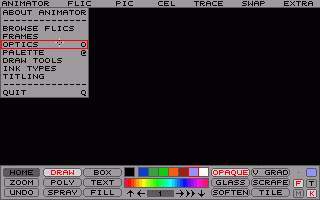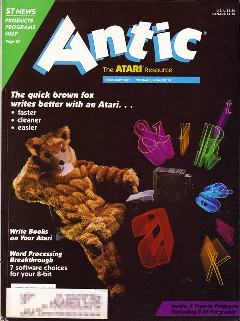Related Research Articles

Atari ST is a line of personal computers from Atari Corporation and the successor to the company's 8-bit home computers. The initial model, the Atari 520ST, had limited release in April–June 1985, and it was widely available in July. The ST was the first personal computer with a bitmapped color graphical user interface, using a version of Digital Research's GEM interface / operating system, from February 1985.

The Atari 8-bit computers, formally launched as the Atari Home Computer System, are a series of 8-bit home computers introduced by Atari, Inc. in 1979 with the Atari 400 and Atari 800. It is the first home computer architecture with coprocessors, enabling more advanced graphics and sound than most of its contemporaries. Video games are key to its software library, and the 1980 first-person space combat simulator Star Raiders is considered the platform's killer app.

Autodesk Animator is a 2D computer animation and painting program published in 1989 for MS-DOS. It was considered groundbreaking when initially released.
Optimized Systems Software (OSS) was a company that produced disk operating systems, programming languages with integrated development environments, and applications primarily for Atari 8-bit computers. The founders of OSS previously developed Atari DOS, Atari BASIC, and the Atari Assembler Editor for Atari, Inc., and many OSS products are substantially improved versions. OS A+ and DOS XL are based on Atari DOS. BASIC A+, BASIC XL, and BASIC XE are based on Atari BASIC. EASMD and MAC/65 are modeled on the Atari Assembler Editor. Action! is an ALGOL-inspired compiled programming language with an integrated full-screen editor. OSS also sold some software for the Apple II.
HomePak, published in 1984 by Batteries Included, is an integrated application written for the Atari 8-bit family and ported to the Commodore 64, Commodore 128, IBM PCjr, and Apple II. It includes a word processor (HomeText), database (HomeFind), and terminal communications program (HomeTerm). HomePak was designed by Russ Wetmore for Star Systems Software, Inc. The Commodore 128 version was ported by Sean M. Puckett and Scott S. Smith.

Atari Logo is ROM cartridge-based version of the Logo programming language for the Atari 8-bit computers published by Atari, Inc. in 1983. It was developed by Logo Computer Systems, Inc. (LCSI) in Quebec, Canada. LCSI wrote Apple Logo, and the Atari version maintains strong compatibility with it.

Antic was a print magazine devoted to Atari 8-bit computers and later the Atari ST. It was named after the ANTIC chip in the 8-bit line which, in concert with CTIA or GTIA, generates the display. The magazine was published by Antic Publishing from April 1982 until June/July 1990. Antic printed type-in programs, reviews, and tutorials, among other articles. Each issue contained one type-in game as "Game of the Month." In 1986, STart magazine was spun off to exclusively cover the Atari ST line.

ANALOG Computing was an American computer magazine devoted to Atari 8-bit computers. It was published from 1981 until 1989. In addition to reviews and tutorials, ANALOG printed multiple programs in each issue for users to type in. Almost every issue included a machine language video game—as opposed to Atari BASIC—which were uncommon in competing magazines. Such games were accompanied by the assembly language source code. ANALOG also sold commercial games, two books of type-in software, and access to a custom bulletin-board system. After the Atari ST was released, coverage of the new systems moved to an ST-Log section of the magazine before spinning off into a separate publication under the ST-Log name.
Antic Software was a software company associated with Antic, a magazine for Atari 8-bit computers. Bound into issues of the magazine, the Antic Software catalog initially sold Atari 8-bit games, applications, and utilities from the recently defunct Atari Program Exchange. Original submissions were later added, as well as public domain collections, with all software provided on self-documented disk. When the Atari ST was released, it became a mixture of Atari 8-bit and Atari ST software and sold some major Atari ST titles such as CAD-3D. The magazine insert changed names several times, eventually being branded as The Catalog.

Spy's Demise is an action game written by Alan Zeldin for the Apple II and published by Penguin Software in 1982. It was ported to the Atari 8-bit family, Commodore 64, TI-99/4A, and Vector-06c. The game contains a puzzle which at the time of release could be solved for a Spy's Demise T-shirt. According to Antic magazine in June 1984, only four people had solved it. The game was followed by a 1983 sequel, The Spy Strikes Back.
Atari Program Exchange (APX) was a division of Atari, Inc. that sold software via mail-order for Atari 8-bit computers from 1981 until 1984. Quarterly APX catalogs were sent to all registered Atari 8-bit owners. APX encouraged any programmer, not just professionals, to submit video games, educational software, applications, and utilities. A few internally developed Atari products were sold through APX, such as Atari Pascal, the developer handbook De Re Atari, and a port of the arcade video game Kangaroo.

Many games, utilities, and educational programs were available for Atari 8-bit computers. Atari, Inc. was primarily the publisher following the launch of the Atari 400/800 in 1979, then increasingly by third parties. Atari also distributed "user written" software through the Atari Program Exchange from 1981 to 1984. After APX folded, many titles were picked up by Antic Software.
Cyber Studio CAD-3D is a 3D modeling and animation package developed by Tom Hudson for the Atari ST computer and published by Antic Software. The package is a precursor to 3D Studio Max.

Wayout is a 3D first-person perspective video game programmed by Paul Allen Edelstein and published for the Atari 8-bit computers in 1982. It was released for the Apple II and Commodore 64 in 1983. Wayout is among the first maze games to offer full 360 degree 3D perspective and movement, and its graphics were considered state-of-the-art upon its release. There were many pseudo-3D maze games at the time, but they used a fixed perspective and limited the player to four orientations.
DEGAS is a bitmap graphics editor created by Tom Hudson for the Atari ST and published by Batteries Included in 1985. Hudson created some of the sample paintings that shipped with DEGAS.
Russ Wetmore is an American programmer and video game designer best known for writing commercial games and applications for Atari 8-bit computers in the early to mid 1980s. His Frogger-inspired Preppie! was published by Adventure International and praised by reviewers for the music and visuals. He also wrote the maze-game sequel, Preppie! II. Wetmore stopped writing games after the video game crash of 1983 and developed the integrated HomePak productivity suite for Batteries Included. He has remained in software development in director and architecture roles.

Gary Yost is an American filmmaker and software designer, best known for leading the team that created Autodesk 3ds Max.

Chopper Hunt is a side-view shoot 'em up written by Tom Hudson and published by Imagic in 1984 for Atari 8-bit computers and Commodore 64. It was one of the last games from Imagic before the company went out of business. Chopper Hunt is an enhanced version of the Atari 8-bit game Buried Bucks released by ANALOG Software in 1982. In both games, the player files a helicopter that uses bombs to unearth buried items. Contemporaneous reviews were mixed.

Quest of the Space Beagle is an action-adventure game written by Scott Lamb for Atari 8-bit computers and published by Avalon Hill Microcomputer Games in 1984. It's the sequel to Jupiter Mission 1999. A Commodore 64 port followed in 1985.
References
- 1 2 3 Jainschigg, John (November 1986). "Gradus ad Parnassum" (PDF). Atari Explorer. pp. 44–49.
- 1 2 Hudson, Tom. "The People of ANALOG Computing". Klanky the Robot's ANALOG Computing Compendium.
- ↑ Hudson, Tom (March 1983). "Fill 'Er Up". ANALOG Computing (10): 100.
- 1 2 Hudson, Tom (April 1984). "HBUG: Hudson's Debugging Utility". ANALOG Computing. No. 18. p. 78.
- 1 2 Pappas, Lee. "ANALOG Software". GearRant.
- ↑ Hudson, Tom (August 1982). "Graphic Violence!". ANALOG Computing (8): 57.
- 1 2 Hudson, Tom (February 1984). "Solid States: A 3-D Object Plotting System". ANALOG Computing (16).
- 1 2 3 Baker, Dave (February 25, 2010). "The History of 3D Studio – Tom Hudson interview". CGPress.
- ↑ Bass, Patrick (January 1987). "DEGAS Elite". Antic. 5 (9).
- ↑ Doudoroff, Martin. "The Antic Cyber Graphics Software and the Pre-History of Autodesk 3D Studio and Discreet 3ds MAX". Archived from the original on April 30, 2013.
{{cite web}}: CS1 maint: unfit URL (link) - 1 2 Friedman, Lex (March 31, 2010). "Star Rangers for iPhone". Macworld.
- 1 2 "Planetary Defense 2012". AtariAge Forums. September 2, 2012.
- ↑ Hudson, Tom (March 1983). "Planetary Defense". ANALOG Computing. No. 17. p. 83.